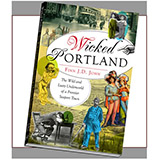REVIEW
Three authors who lied
A critical examination of three recent critically acclaimed nonfiction books that have turned out to be entirely fabricated: What they mean, and what they tell us about ourselves
By FINN J.D. JOHN
January 2010
Let’s say you’re eager to make a name for yourself in the world of nonfiction book writing.
You could find a subject that interests you and write one of those heavy, research-y books about something like butterflies, or disappearing coral reefs, or the sex life of aquatic bivalves. But you know stuff like that doesn’t sell well enough to support you in the lifestyle to which you might like to become accustomed.
You could drop everything and immerse yourself in something for a year or two, like the culture of motorcycle gangs or undocumented immigrants, or maybe something that would let you crank out one of those “My Year of” books (living Biblically, eating locally, drinking heavily, etc.). But that’s a lot of work. And who’s going to pay the bills while you’re living in a yurt on the Mongolian steppe?
There is, of course, a third possibility. It seems to have everything going for it. It’s quick. It’s pleasant. You can do it right from your own home or, if you prefer, from your stateroom on a Royal Caribbean liner. And, best of all, you have complete control. No pesky facts will crop up in the wrong spot to spoil your “teachable moments”; your heroes can be heroic and your villains can be worthy of repudiation by their own mothers. It can get you on a first-name basis with Oprah and with reporters from The New York Times.
It’s simple: You just stay at home and make stuff up.
Oh, yes, there are drawbacks to this method. There is, for instance, the small matter of the Ninth Commandment, if you believe in that sort of thing. And then, too, members of your immediate family can get annoyed with you if they get dragged into your book and, oh, I don’t know, accused of being child molesters or something. And, of course, there’s also the risk of being told off on national TV. But hey, nobody said success in this business was easy.
The books we’re looking at here are confessed fakes. Although inspired by real stories, they have been spun off so fancifully that they are utterly unrecognizable.
The Wolf-Girl of Belgium: Misha Defonseca
Of these three books, Misha Defonseca’s is the most straightforward. A straight-up personal fantasy, it claims to tell the story of a (blonde, blue-eyed) Jewish girl who sets out across Europe during World War II to find her missing parents. She recounts witnessing mass executions of children and the rape and murder of a young girl by a Nazi soldier (whom she subsequently stabs to death). She also claims to have sneaked into and out of the Warsaw Ghetto.
She sets up a strong contrast between the goodness of animals and the evil of humans and casts her lot with the former, describing having been adopted into two different wolf packs and claims to have joined the “other” puppies in slurping up the mother wolf’s vomit, which had been belched forth for the pups’ dining pleasure.
Defonseca turns out to have been just four years old when the war broke out, not seven. It also turns out she’s not of Jewish descent, although she has since adopted the faith.
Suspicion dogged the book for years after it was published in 1997, but to question it put one into some very scaly company – specifically, the holocaust deniers. Finally, several years ago, she admitted the book was a complete fake, thereby handing those holocaust deniers a “talking point” (and as good as the Nazis were at recordkeeping, anyone determined to think the Holocaust was a myth needs all the help he/she can get).
While what she did cannot be condoned, a reader has to give her some credit for experiencing the Nazi occupation of Belgium during the war as a helpless, wide-eyed toddler watching Jewish neighbors being trucked away to their doom. It’s also telling that she adopted the Jewish faith afterward. It’s easy to imagine this fantasy as having come out in response to that experience.
A Million Little Swindles: James Frey
James Frey’s book tells the story of himself waking up on an airplane, covered with blood and vomit (perhaps a recurring theme in the fake memoir?) and bits of broken teeth, on his way to a rehab center. Then we get to watch his stint in rehab, which apparently is a lot like one of those “tough-love” camps for rebellious teens – no talking to the girls, mandatory pep rallies for sobriety, etc. In spite of this he meets a woman, whom he gets to rescue from an incipient relapse at the end; makes connections with some very important people; fights with the director over whether Alcoholics Anonymous is a cruel swindle; and, in the end, proves his mastery of himself by ordering a pint of whisky at a bar, sitting there sniffing it, and then getting up and walking away from it. Some other tough-guy heroics happen along the way as well, but you get the idea.
The whole thing is written in a sort of clunky stream-of-consciousness style, with no indentations, and with random words capitalized. It’s hard to imagine a college graduate thinking this was how books are written, so most likely he adopted this style to lend his prose some street cred. As with Madonna’s affectation of a British accent, it lends a disingenuous quality to the work.
Frey’s book is quite difficult to view with charity. Primarily, this is because he presents it as a story of the triumph of personal toughness over what he’d call the “victim mentality” of the twelve-step programs that are the dominant paradigms of modern rehab. The book was hugely successful, and Frey soon became like a rock star or a diamond-level Amway guy, touring the country to tell huge crowds about his success and to assure them that “if I can do it, so can you!”
But, well, turns out he didn’t. And most likely, they can’t, either. Worse, for those two and a half years Frey was preaching his alternative to Alcoholics Anonymous, recovering alcoholics and drug abusers nationwide believed in his message and strove to emulate it. Who knows how many people tried, and failed, to get sober the James Frey way? Who knows how many people, in a chemically induced free-fall, pissed away their last chance to get things back together following this false prophet?
If Defonseca’s lies didn’t affect many people directly, Frey’s must have ruined some. This might be why Oprah, who had previously endorsed this book, brought Frey on to publicly chastise him on TV rather than just letting the whole thing quietly die. She likely felt some responsibility for audience members who might have been led astray.
To add insult to that injury, when the wheels were coming off Frey’s propaganda machine, he fought shamelessly to keep his franchise. Even today, he’s blithely pushing a new book – this one admittedly fiction. (And it’s not selling too badly. Perhaps it’s really true that there’s no such thing as bad P.R.)
The blonde gangsta: Margaret B. Jones
Margaret B. Jones’ book is more tolerable. And yet … it may be the most toxic of the three – not so much because of what it says as what it is.
In it, Jones – whose real name is Peggy Seltzer – spins a yarn of being taken from an abusive family at age 5 and placed for foster care with a woman known as “Big Mom” in south-central Los Angeles, in the heart of Blood territory. She describes growing up there, getting plugged into the gang, the murders of people close to her, seeing Big Mom’s despair as she watches her sons become gangstas, and finally getting out of the neighborhood by applying to a university.
The main point of the book seems to be to humanize gang members and their families, to cast south-central Los Angeles in a light that makes it accessible to others, so that they can relate to the stories of people they might otherwise dismiss as too different to understand. It’s hard to criticize this goal -- but very easy to criticize her methods.
Jones’ falsification was exposed by her sister, who resented the allegation that she came from an abusive family.
One of the most startling parts of the book is its scrupulous color-blindness. Jones is accepted into the neighborhood without a murmur, and none of the other people seem to comment on the fact that she looks different – even people who don’t know her. But this is the world as we wish it could be, not as it is. People do judge other people on looks, and the unremarkableness with which she says a young Caucasian girl with light-brown hair was received into a community that’s overwhelmingly African-American is striking.
But then, no amount of this sort of thing can change the fundamental problem with this story. It’s similar to the issue the modern reader has with much of Rudyard Kipling’s work – a fundamental insinuation of Caucasian exceptionalism: The narrator is the only Caucasian person in the whole neighborhood – and she is also the only person in the whole neighborhood to escape, through wits and intelligence and determination, the poverty-spawned culture of murder and incarceration and early pregnancy that have the neighborhood by the throat. Coincidence? Or is there maybe something about being Caucasian that makes it different for her than for the thousands of other girls her age in south central? This is simply not something that can be fixed. It transcends the story. And all her efforts to bring the “races” together and show the human side of people -- if such was truly her goal -- are destroyed by it.
Common denominators
These three books – as well as others of their ilk (Lorenzo Carcaterra’s Sleepers comes immediately to mind) – have quite a bit in common.
Each was written by a poser, someone pretending to be far cooler than he/she actually is. More specifically, each was written by someone with a middle-class upbringing, who romanticized or in some way envied the “colorful” and “dramatic” life of the less fortunate and wanted to share that color and drama without having actually lived that life.
Each of these books is also – how to say this? -- stuffed with whoppers. They’re full of assertions and scenes that, even allowing for the perfect vision of hindsight, should have tipped off readers (not to mention their editors) they were fakes. Frey describes having dental work done with no anesthetic. The rehab center he’s checked into is giving him Lorzepam every day, but topical Novocain administered by a dentist somehow violates their anti-drug policy. Jones names her two brothers after a football player and an actor (“Terrell” and “Taye,” as in Mesrs. Owens and Diggs ) and her foster mother after a character from a Martin Lawrence movie (“Big Mom” – apparently, “Big Momma” would have been too obvious). Defonseca assures us she was adopted into not one, but two wolf packs and treated as a puppy. And then there’s the vomit thing.
One has to wonder how anyone was able to suspend his/her disbelief long enough to swallow these tall tales. One also has to wonder what would have happened if these authors had been more subtle. Had they not inserted these unrealistic details, might they have gotten away with it? Are there other works of fake nonfiction out there right now, more subtly crafted, that are getting taken as fact?
Then there’s the issue of stereotypes – more specifically, of taking stereotypes to the bank and redeeming them for cash. As these three writers sat down and made up characters and situations for their “nonfiction” works, they naturally reached for what was in their minds already. When they did so, they pulled out a toxic jumble of popular stereotypes, fraudulently invested with the credibility of eyewitness testimony, and sold them to people who wanted to believe in them. For example, Frey’s best buddies in rehab are (a) a Sicilian-American who is the top dog in the West Coast mafia; (b) an African-American who’s a jazz clarinet virtuoso; and (c) the former featherweight champion of the world, also African-American. The guy has obviously seen too many movies and too little real life.
More fundamentally, though, the core messages of these books borrow heavily from middle-class myths: that addicts just need to suck it up, “those people” really are “like that,” that it takes a cute little blonde girl to bring hope and light to the darkness of Gangland. This is the real poison here. For people who share these cultural stereotypes, these writers are selling confirmation of prejudice. And not just any prejudices, either – the prejudices that exist for the convenience of the people who hold them, so that they don’t have to get emotionally involved in things like gang-violence victims and drug abusers’ lives. Having someone with a lot of credibility come along and tell you you’re right – that African-American people really are “like that,” or that crack smokers really are a lost cause and just need to be cut off from Welfare – why, that’s quite valuable. People will pay good money for that.
A case for faking it (kind of)
So, is it always bad to fake a nonfiction story?
The answer to that question is far more complicated than it seems. Consider Rigoberta Menchu Tam’s book, Me Llamo Rigoberta Menchu y Asi Me Nascio la Conscienza (in English, I, Rigoberta Menchu) (Buenos Aires: Siglo Veintiuno, 1985).
This book was first published in 1983 when Guatemalan army units were massacring whole Maya Indian villages in a campaign to deny their resources to their guerilla enemies. Later this would be called “ethnic cleansing.” At the time, “mass murder” worked just fine. It wasn’t quite genocide, but it was pretty close.
Menchu told the story of her upbringing in a poor Maya village. Villagers raise crops when they can, and work on plantations when they must; their children die of malnutrition and of poisoning from aerial spraying, and they are treated like animals by ladinos (Guatemalans of partial Spanish descent – generally, though not always, the middle and upper classes). Then, as she tells it, government-backed Ladinos started taking away the village land and forcing the residents into starvation. They take up arms. Both her parents are killed by the military but not before being forced to watch her brother burned alive as an example.
The truthfulness of the book came into question about 10 years later, when an anthropologist unearthed some inconsistencies. After an initial period of resistance, Menchu admitted she had blended some other Mayas’ stories into her own, basically making herself into a composite character.
An outrage? Yes, if you ask Dinesh D’Souza or Ronald Reagan, or anyone else who was eager to feel good about U.S. support for the Guatemalan regime at the time. And they may be right. But there are some critical differences here. First, Menchu is not an author. She is, for lack of a better term, a politician. And she won the Nobel Peace Prize in 1992 not for writing a book but for the key part she played in stopping the nascent genocide in the mountains of Guatemala. This book was a tool she used to do so – probably the most effective one – by bringing the horrified eyes of the international community to bear on Guatemala. It was written as a plea, not a commercial venture. Its aim was not self-aggrandizement but rather human survival. Could she have accomplished the same thing without lying? Maybe. But then again, maybe not.
I am close, here, to saying the end sometimes justifies the means. But I won’t. What I will say is that playing loose with facts in the guise of writing nonfiction is, and will probably remain, one of the thornier – and more interesting – subjects writers (and readers) can debate.






